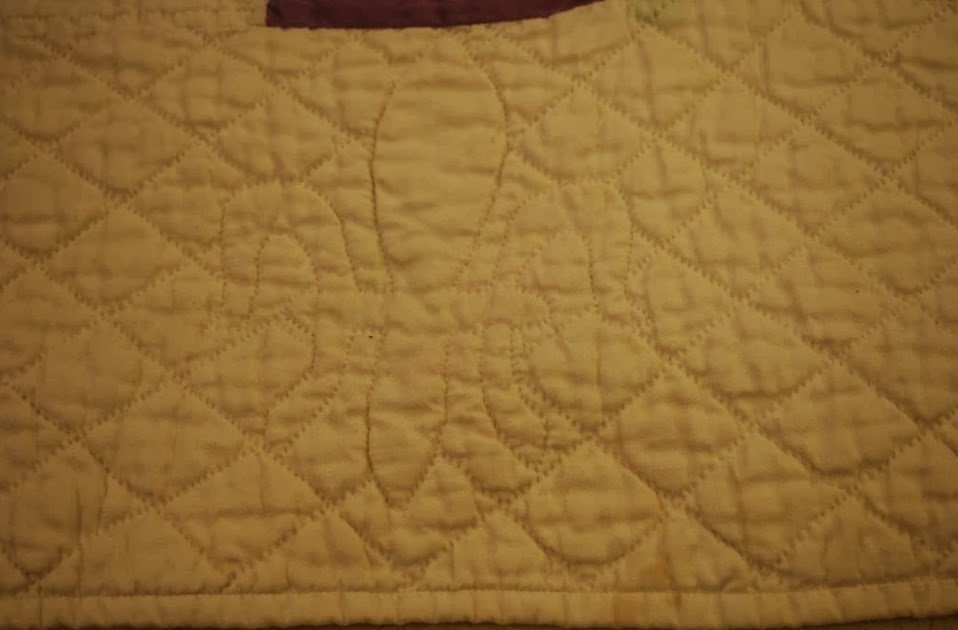See Bed Turning-Part #1 by clicking here.
Continuing with our first Bed Turning from the October 20, 2013 meeting of the Washington Quilt Study Group.
10. Kathy Anderson: This appears to be a basic Shoe Fly pattern with color placement variations. See BB# 1645 page 209 in Barbara Brackman's Encyclopedia of Pieced Patterns (1993) (ISBN 0-89145-815-8).
Beautiful example of finishing a vintage top. Excellent use of reproduction fabrics to complement the original top. Kathy finished the top approximately 8 years ago. The backing is a great reproduction of mourning print fabric. This quilt would have been a good addition to Mary Kerr’s study center, “To Finish or Not to Finish” at the 2013 AQSG Seminar in Charleston.
You can also read more about finishing old tops here and here
11. Kathy Nannery: Kathy brought a crazy quilt owned by a friend. It was an estate sale purchase from Pennsylvania. Scrap-bag top with fabrics 1880s-1910 era. Fabrics appear to be from work clothes, possibly railroad uniforms. Many people worked for the railroad in the area the top was purchased. Quilt maker turned right side of backing fabric toward the "inside" of the top so that it could not be seen from either the front or back of the piece—interesting she would do that. If you still have your photos and notes from Ginny Gunn’s 2012 Study Center you could probably assign closer dates on some of the late 19th and early 20th century quilts. Might be a good future study group topic.
12. Susan Underwood: Dark brown, pink, and beige “southern” quilt with checked backing fabric. Purchased from Cindy Rennels, Oklahoma, in 2000. Probably 1880-1900. Very dark brown print fabric has not faded—possibly a vegetable dye referred to as “chocolate brown” (Brackman “Clues”). Possible Southern indicators: boldness and scale of design (?), thick bat (upper South), fan quilting and the spacing of the fan quilting, gingham check back, knots on surface of quilting.
13. Margaret Parcel: Tumbler quilt. Family quilt. Scrap-bag quilt with a wide range of fabrics. Includes “Garibaldi” prints (red and black), blue prints with flashes of cheddar orange. 1880-1900?
(See page 118 of Dating Fabrics-A Color Guide 1800-1960 by Eileen Jahnke Trestain for examples of red & black as well as Margo Krager's website Cottonopia, where you can click thru to reproduction attempts of this particular color/design.)
14. Dawn Barrow: Delectable Mountains, blue on what is now a tan background. Probably a fine quilt when made—beautiful quilting. Very large, top is folded over to the back for binding. Second half of 19th century, probably closer to 1860. Backing fabric also indicates an earlier date. Memorable feature is the iron-on tape used to mend the back. Brackman's BB#2401 on page 303 seems to most resemble this pattern.
15. Kathy Nannery: Second quilt Kathy brought for her friend Jean. Quilt is dated 1919. Beautiful bright colored fabrics. Quilt does not have the elaborate variety of stitches of many 19th century crazy quilts. Only one stitch used around each block (feather stitch?). No embroidered flowers, names, etc. The fabric pieces are smaller than the typical crazy in the heyday of this style. Fabrics possibly from a dressmaker’s stash rather than the larger pieces collected by a Victorian lady specifically for her crazy quilt. The fabrics not the stitching dominate the quilt. Fabrics could also be purchased by the pound for quilts, but these are particularly nice fabrics. The brilliant pink repeat ties the design together well.
If you would like to read more about the history of Crazy Quilts, check out Cindy Brick's book and Penny McMorrison's book. Both are excellent quilt history books. Alex Anderson and Ricky Tims also have an interesting segment on Cindy here. (However, you'll have to be a paid member to watch it.)
16. Kathy Nannery: 9-patch alternating with square blocks of a “faux” fabric (the print mimics a woven fabric pattern). Pieced blocks include one bears-paw square. The pieced blocks are probably older than the “faux” squares, which are the alternative blocks. Pieced blocks appear to be 1880-1890. The “faux” squares appear to be early 20th century, but more research would be needed to confirm this.
17. Delaine Gately: Red and blue 8-point diamond stars on a white ground with wonderful, elaborate quilting. Unique leaf quilting pattern in the borders. Circa 1870?
18. Delaine Gately: Appliqued lavender, purple, and green tulips with purple sashing on cream background. Made by Helen Estey (?) of Illinois (Karen, my notes are sketchy on the reference to Helen Estey). Quilt has been appraised and it is an original pattern. Diamond quilting with flor de lis pattern in border; quilting is 12 stitches per inch. Stems and leaves are of green sateen, a fabric Marie Webster used in many of her quilts.











































